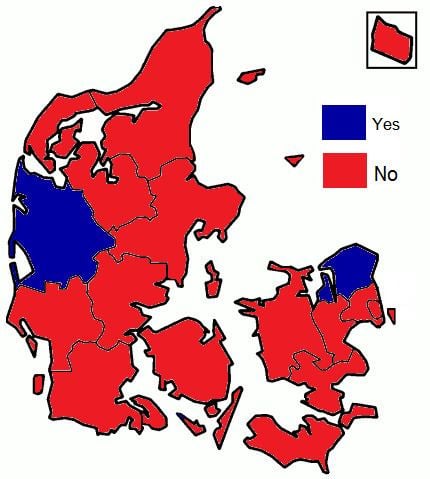 | ||
A referendum on joining the euro was held in Denmark on 28 September 2000. It was rejected by 53.2% of voters with a turnout of 87.6%.
Contents
Background
On 2 June 1992, Danish voters rejected the Maastricht Treaty in a referendum. On 18 May 1993, Denmark ratified an amended treaty in accordance with the Edinburgh Agreement. This meant that, among three other areas, Denmark would not be part of the European Monetary Union (EMU). In March 2000, as the currency was being launched, the Danish government led by Poul Nyrup Rasmussen, a supporter of the common currency, decided to hold a referendum on Danish entry into the monetary union. In May 2000 the government tabled the bill. According to the bill, if the outcome of the referendum was in favour of adoption of the euro, Denmark would be able to join the euro area as from 1 January 2002 with the euro as "book money". Euro banknotes and coins would be introduced as from 1 January 2004, after which krone banknotes and coins would be withdrawn.
The largest political parties, including the opposition Liberals and Conservatives, were all in favour entering the EMU. So were the industrial and banking sectors and the majority of labour unions. Only one national paper (Ekstra Bladet) came out against EMU. Five political parties did oppose EMU: two right-wing parties (the Danish People’s Party and the Progress Party), two left-wing parties (The Socialist People's Party and The Red-Green Alliance) and the centre-right Christian People’s Party. However, these parties were all relatively small and represented only 39 of 179 seats in parliament at the time).
Campaign
When the referendum was called, support for the "Yes" side was just below 50% while the "No" side was just below 40% according to opinion polls. However, public opinion shifted and from June 2000 until the referendum in September all polls showed 15–20 per cent undecided and an almost fifty-fifty split between EMU-supporters and EMU-sceptics.
Several factors eroded support for the "Yes" side:
